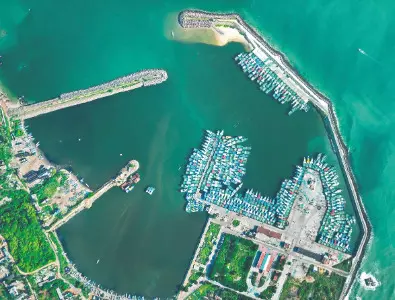Smart Harbours, Stronger Shores
With smart harbours, digital traceability, and value-added exports, India’s fisheries sector is scripting a transformation — from traditional livelihoods to a high-tech global blue economy

India’s fisheries and aquaculture sector has emerged as a global leader in the blue economy, with nearly 8 per cent share in global fish production. The country’s seafood exports to more than 132 countries have doubled to USD 7.45 billion during the last ten years. China, the US, Japan, and the EU are its main export markets. Frozen shrimp is the main export commodity among frozen fish, squids, octopus, etc. India aims to further expand its seafood exports in other global markets such as South Korea, the UK, and Southeast Asia, with a focus on value addition (e.g., ready-to-eat/cooked and canned). Besides, these global markets are increasingly demanding enhanced food safety and sustainable compliance.
In the above context, fishing harbours are critical nodes in the seafood export value chain that enable activities such as vessel berthing, catch unloading, auctioning, cold chain storage, etc. These activities are a stepping stone for further seafood processing and value-added services. Fish harbours are also gateways in coastal areas that directly influence the lives and livelihoods of fisher communities.
A game-changer in the development and upgradation of fish harbours has been the flagship programme, Pradhan Mantri Matsya Sampada Yojana (PMMSY). A tangible spin-off of investments made under this flagship programme has been the reduction of post-harvest losses from 25 per cent to 10 per cent due to enhanced vessel berthing facilities as well as cold storage capacity. Approximately 3,000 “Sagar Mitras” in coastal states/UTs, supported under the programme, act as a vital interface between the government and fisher communities. They compile information/data on daily marine catch, price fluctuations, and requisite marketing needs at fish harbours. They also disseminate information to fishers on weather forecasts and, more importantly, potential fishing zones in the seas.
What is needed ahead is a still more efficient, hygienic, and environmentally responsible fish harbour management system that meets international standards to boost seafood exports. With the latter in mind, “Smart and Integrated Fish Harbours” have been conceptualised to enable real-time information flow.
A key input in the above has been the Blue Ports Initiative of the Food and Agriculture Organisation (FAO), which promotes the transformation of fishing harbours into hubs of sustainability, innovation, and inclusive growth. The Government of India has tapped into this initiative to set up a three-year cooperation programme that will support the strengthening of the technical capacities of all stakeholders with regard to strategic interventions in the fish harbour activity process flow. Such interventions will include digitalisation (application of 5G, AI technologies, etc.) to track the traceability of fish catch and its certification, along with low-carbon footprint initiatives. A robust local government and fisher community engagement plan, in addition, will support the finalisation of all state-of-the-art strategic and operational interventions.
Three such smart fish harbours have been approved to be built at Vanakabara (Daman & Diu), Karaikal (Puducherry), and Jakhau (Gujarat). The three-year FAO technical cooperation programme will expose both public and private stakeholders at these locations to best practices from fishing harbours at Busan, Brest, Vigo, and Tangier Ville in countries such as South Korea, Spain, and France. A key learning herein will be the modalities of housing primary and secondary fish processing entities within the fish harbour premises for more efficient post-harvest management.
In fact, high-value fish traded globally through such smart harbours include Tunas and Tuna-like species, etc. These are valued at USD 18 billion. Four steps can have a significant impact on India’s participation in the trade of such fish species to enhance our value-added seafood exports.
* First, developing smart fish harbours will effectively address any market access concerns pertaining to traceability, certification, and other sustainability compliances that importing countries require.
* Second, fish processing units are primarily located in the states of Gujarat, Kerala, Maharashtra, Andhra Pradesh, Karnataka, Odisha, and Tamil Nadu, which contribute majorly to seafood exports. These units need to be strengthened with modern facilities such as breading, battering, filleting, freeze-drying, individual quick freezing, chilling, and canning lines if value addition is to go up from the current 11 per cent to 30 per cent over the next five years.
* Third, it is important for our robust Indian Council of Agricultural Research (ICAR) R&D setup in coastal states to support innovations by start-ups such as “Blue Catch”, which are exploring digitised fish harbour management with the application of artificial intelligence.
* Fourth, the Government of India is putting in place a governance framework to encourage sustainable deep-sea fishing in the Exclusive Economic Zone (EEZ) as well as the High Seas. Fish Farmers Producer Organisations (FFPOs) and Fisheries Cooperatives will be important partners in this endeavour. Interestingly, almost 50 per cent of India’s EEZ falls in the Andaman & Nicobar and Lakshadweep Islands. Backed by smart fish harbours, these islands will also unleash the potential of harnessing approximately two lakh tons of Tuna and Tuna-like species for value-added seafood exports.
Views expressed are personal. The writer is Secretary, Department of Fisheries, Ministry of Fisheries, Animal Husbandry & Dairying, GoI



